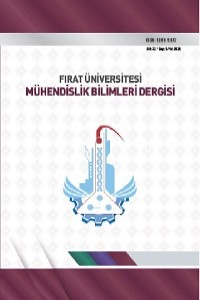Irak ve Batman Bitümleri Kullanılan SEBS Modifiyeli Bağlayıcıların Reolojik Özelliklerinin İncelenmesi
Öz
Çalışmada, Kuzey Irak’ta bulunan LANAZ rafinerisinden ve Batman TÜPRAŞ rafinerisinden 2 farklı B 160/220 sınıfı saf bitüm temin edilmiştir. Bu bitümlere 3 farklı oranda (%2, %3 ve %4) stiren-etilen-bütadien-stiren (SEBS) ilave edilerek modifiye bitümler hazırlanmıştır. Saf ve modifiye bitümlere penetrasyon, yumuşama noktası, iki farklı sıcaklıkta (135 ve 165°C) dönel viskozite deneyleri uygulanmıştır. Ayrıca dinamik kayma reometresi (DSR) deneyleri ile tekerlek izi oluşumuna karşı dayanım parametreleri (G*/sin δ) belirlenmiştir. Farkı sıcaklık ve yükleme hızlarında DSR deneyi uygulanarak farklı koşullarda kompleks kayma modülü (G*) değerleri ile faz açıları belirlenmiştir. SEBS katkısı kullanılması ile bağlayıcıların penetrasyon ve faz açısı değerlerinin azaldığı, yumuşama noktası, viskozite, tekerlek izi parametresi, kompleks kayma modülü değerlerinin ise arttığı tespit edilmiştir. Yapılan analizler sonucunda yüksek sıcaklık dayanımı açısından Irak LANAZ rafinerisinden temin edilen bitümün Batman TÜPRAŞ rafinerisinden temin edilen saf bitüme göre daha olumlu sonuçlar verdiği belirlenmiştir. Modifiye bitümler değerlendirildiğinde Irak LANAZ bitümüne göre Batman TÜPRAŞ bitümü kullanılması durumunda daha etkili modifiye bitümler elde edildiği tespit edilmiştir.
Anahtar Kelimeler
Kaynakça
- [1] European Committee for Standardization EN 12597 Bitumen and Bituminous Binders- Terminology; European Committee for Standardization: Brussels, Belgium, 2000.
- [2] Paliukait, M.; Vaitkusa, A.; Zofkab, A. Evaluation of bitumen fractional composition depending on the crude oil type and production technology. In Proceedings of the 9th International Conference “Environmental Engineering” Selected Papers, Vilnius, Lithuania, 22–23 May 2014.
- [3] Read, J.; Witheoak, D. The Shell Bitumen Handbook, 5th ed; Thomas Telford Publishing: London, UK, 2003.
- [4] Lesueur, D. The Colloidal Structure of Bitumen: Consequences on the Rheology and on the Mechanisms of Bitumen Modification. Adv. Colloid Interface Sci. 2009; 145, 42–82.
- [5] Porto, M., Caputo, P., Loise, V., Eskandarsefat, S., Teltayev, B., & Oliviero Rossi, C. Bitumen and bitumen modification: A review on latest advances. Applied Sciences, 2019; 9(4): 742.
- [6] Dong, F., Zhao, W., Zhang, Y., Wei, J., Fan, W., Yu, Y., & Wang, Z. Influence of SBS and asphalt on SBS dispersion and the performance of modified asphalt. Construction and Building Materials, 2014; 62: 1-7.
- [7] Djaffar, S. B., Samy, D., & Khadidja, A. M. Rheological properties and storage stability of SEBS polymer modified bitumen. International Journal of Engineering Science and Technology, 2013; 5(5): 1031-1038.
- [8] Zapién-Castillo, S., Rivera-Armenta, J. L., Chávez-Cinco, M. Y., Salazar-Cruz, B. A., & Mendoza-Martínez, A. M. Physical and rheological properties of asphalt modified with SEBS/montmorillonite nanocomposite. Construction and Building Materials, 2016; 106: 349-356.
- [9] Bachir, D. S., Dekhli, S., & Mokhtar, K. A. Rheological evaluation of ageing properties of SEBS polymer modified bitumens. Periodica Polytechnica Civil Engineering, 2016; 60(3): 397-404.
- [10] Lu, X., Isacsson, U., & Ekblad, JRheological properties of SEBS, EVA and EBA polymer modified bitumens. Materials and Structures, . 1999; 32(2): 131-139.
- [11] Polacco, G., Muscente, A., Biondi, D., & Santini, S. Effect of composition on the properties of SEBS modified asphalts. European polymer journal, 2006; 42(5): 1113-1121.
- [12] Zhu, J., Birgisson, B., & Kringos, N. Polymer modification of bitumen: Advances and challenges. European Polymer Journal, 2014; 54: 18-38.
- [13]. Ashoori, S.; Sharifi, M.; Masoumi, M.; Salehi, M.M. The Relationship between SARA Fractions and Crude Oil Stability. Egypt. J. Pet. 2017; 26: 209–213.
- [14] King GN, King HW, Harders O, Arant W, Planche PP. Influence of asphalt grade and polymer concentration on the low temperature performance of polymer modified asphalt. Asphalt Paving Technologists 1993; 62: 1-22.
- [15] Brulé B, Brion Y, Tanguy A. Paving asphalt polymer blends; relationships between composition, structure and properties, Proc. Assoc. Asphalt Paving Technologists 1988; 57: 41-64.
- [16] EN 1426.. “Bitüm ve Bitümlü Bağlayıcılar-İğne Batma Derinliği Tayini”, Türk Standartları Enstitüsü, Ankara 2015.
- [17] EN 1427. “Bitüm ve Bitümlü Bağlayıcılar-Yumuşama Noktası Tayini-Halka ve Bilye Metodu”, Türk Standartları Enstitüsü, Ankara 2015.
- [18] AASHTO TP 5. “Standard Test Method for Determining the Rheological Properties of Asphalt Binder Using a Dynamic Shear Rheometer (DSR)”, American Association of State Highway and Transportation Officials (AASHTO), Washington DC, 1998.
- [19] ASTM D4402/D4402M. “Standard Test Method for Viscosity Determination of Asphalt at Elevated Temperatures Using a rotational Viscometer”, ASTM International, West Conshohocken, PA., 2015.
- [20] McGennis, R. B., Shuler, S., & Bahia, H. U. (1994). Background of Superpave Asphalt Binder Test Methods, National Asphalt Training Center Demonstration Project 101, Publication No. FHWA-SA-94-069, Asphalt Institute, Lexington, KY,104p.
- [21] Airey, G. D. Styrene butadiene styrene polymer modification of road bitumens. Journal of Materials Science 2004; 39(3), 951-959.
Ayrıntılar
| Birincil Dil | Türkçe |
|---|---|
| Konular | Mühendislik |
| Bölüm | MBD |
| Yazarlar | |
| Yayımlanma Tarihi | 3 Mart 2020 |
| Gönderilme Tarihi | 8 Temmuz 2019 |
| Yayımlandığı Sayı | Yıl 2020 Cilt: 32 Sayı: 1 |


